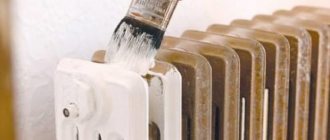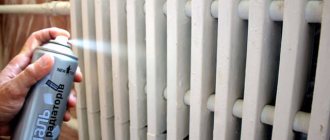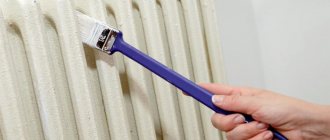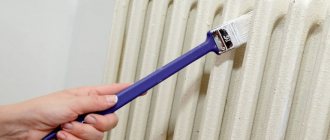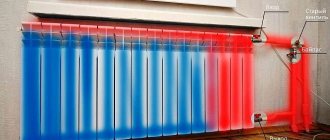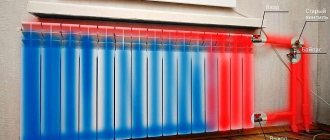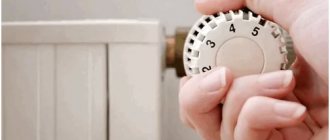Is it possible to paint hot radiators? This question worries those who were delayed in renovating their apartment in the summer and had to do it during the heating season. Paints are a product of the chemical industry and people have concerns about how a fresh paint coating will “behave” on the surface of a hot metal.
In this article, the reader will learn what risks may arise and how to avoid them when painting hot batteries. Here are tips on how to prepare a radiator for painting, what is the best way to paint it, and what type of paint to use for the heating device, depending on its type. Step-by-step instructions will help with this.
You also need to prepare paint, tools and the necessary materials, arm yourself with personal protective equipment, and only after that proceed directly to the painting itself.
How to paint a radiator correctly: tips for choosing paint
Heating radiators are a common part of the interior of apartments and houses.
Even after high-quality and expensive repairs, the home will not look well-groomed and cozy if the batteries are peeling or rusty. Painting heating radiators not only improves their appearance, it prevents direct contact of the metal with atmospheric oxygen and moisture, therefore significantly increasing their service life.
Replacing heating radiators is an expensive and time-consuming process, so not every family can afford it. Painting radiators will be a real lifesaver. Anyone can do this job, as you don't need any special skills to do it. Let's consider how to properly paint a radiator, the necessary tools and materials, features of the selection of paints for batteries and the step-by-step implementation of the work.
- a brush with metal bristles;
- paint brushes: regular and special radiator brushes (the distinctive feature of the latter is the long curved handle, which will allow you to paint even hard-to-reach places);
- coarse sandpaper;
- dust brush;
- spatula or knife.
In the process of staining and preparation for it, you will need the following materials:
- primer for metal;
- coloring composition;
- solvent.
Aluminum batteries
Unfortunately, it is almost impossible to paint batteries made of aluminum or bimetal at home yourself. Such products are painted in factories using a special powder dye. It is applied using special equipment, and it is impossible to repeat this procedure at home.
Expert opinion
Grebnev Vadim Savelievich
Heating system installer
Photo printing can be used to restore the aesthetic qualities of aluminum batteries. The photographic image is attached to the outside of the batteries. It tolerates high temperatures and extremes very well.
Selection of coloring composition
Painting pipelines and heating radiators is a responsible job that poses the question to the performer: how to paint these parts? For painting, you can only use compounds that protect the metal from rust and are resistant to high temperatures. Central heating radiators heat up to a temperature of 60-80 degrees Celsius. The paint for a heating radiator should not change its original color when heated, peel off from the surface, collapse, or release toxic substances into the air.
Advice! After painting, an unpleasant odor remains in the room for a long time. Odorless battery paint makes it possible to carry out work even in a residential area.
- acrylic;
- alkyd enamel;
- water-dispersed;
- silicone-based paint for radiators;
- based on heat-resistant varnish.
Acrylic enamel for radiators is designed for temperatures up to 80 degrees. When dry, it forms a glossy surface whose color lasts for a long time. This paint for heating pipes is odorless, so it is suitable for work in residential areas. The basis of this composition is white enamel, to which the required amount of pigments is added.
Alkyd enamel for radiators contains organic solvents. The strength of the enamel coating is higher than that of acrylic compounds. It evenly covers the surface and is resistant to temperature influences. The disadvantage of alkyd compositions is a peculiar unpleasant odor that can remain in the room for a long time even after drying.
Advice! If you have chosen alkyd compounds to paint heating radiators, opt for dark shades. Light pigments (especially white) that make up these enamels lose their brightness over time and turn yellow.
The question often arises: is it possible to paint radiators with a water-based composition? It is possible and necessary! This odorless metal paint is suitable for heating pipes and radiators in residential premises.
Painting pipes and cast iron heating radiators with two-component enamels, consisting of heat-resistant varnish and metallized particles, has become popular. Such compositions give the batteries shades of gold, silver, bronze, and with their help you can stylize radiators in an “antique” way. The advantages of these products include low cost and durability of the coating.
Zinc metal paint is also suitable for painting metal batteries. It will not only update the appearance, but also, thanks to its anti-corrosion properties, will extend the life of the radiator.
Source: trubexpert.ru
Requirements for enamel
The main thing in choosing paint for a home heating radiator is its heat resistance. If the labeling of the can indicates that the composition has an operating temperature below +80°C, then you should not use such paintwork for painting the battery.
Conventional paint and varnish materials are not initially intended for painting heated elements of the heating system. After turning on the heating, they will begin to peel off or turn yellow.
The best paint for batteries is one whose label says “designed for heating radiators” and “quick-drying.”
The paint for painting the heating device yourself must be at the same time:
- heat-resistant - at least +80°C, and preferably +100°C;
- moisture-resistant and abrasion-resistant;
- non-toxic;
- with high thermal conductivity;
- quick-drying.
Due to inexperience, some choose ordinary non-heat-resistant paint for interiors for batteries. As a result, when heat is applied, it turns yellow or changes its original shade.
This is due to the presence of chalk or polymers in its composition, which are not designed for high temperatures. Therefore, both the binder material and the pigment must be heat resistant.
The paint on the battery is usually applied in two layers. The faster each of them dries, the faster the radiator will be ready for use. Moreover, often the faster the paintwork dries, the more pungent the odor of the composition.
So that the family is not forced to inhale these ambers, it is often easier to remove the heating device from the pipes and paint it somewhere in the garage or on the street.
Inexpensive chalk is often added to paint as a filler to reduce its cost; it is better to discard such paint and varnish immediately - such enamel will definitely turn yellow
When choosing between a glossy and matte option, you should remember that the slightest irregularities are noticeable on a shiny surface. For rough and lumpy cast iron batteries, it is better to choose a paint with a dull shade that will not produce glare from lighting.
Radiator cast iron often has metal streaks and chips. When using glossy enamel, all of them will definitely be visible.
At the same time, you should not be overly zealous in leveling the cast-iron surface of the battery with sandpaper before painting. This can lead to thinning of the radiator fin and the subsequent appearance of a fistula.
How to paint heating radiators: water-based emulsions, universal enamels, anti-corrosion primers
You may have already faced the question of how to paint radiators, and if you solved it, then that’s, of course, good. If not, then you will find out about it now. The peculiarities of such painting work lie not only in paint and varnish materials, but also in finishing tools, as well as the heaters themselves, which can also be different.
So, if you want to choose a paint composition that is exactly suitable for your case, stay with us. And the video in this article will complement our material with visual information.
Painting radiators: a creative approach
Staining order
The algorithm for painting radiators is as follows:
- the walls behind the radiators and the floor under them are covered with film;
- the paint is thoroughly mixed. If necessary, tinted at the same time;
- poured into a cuvette;
- Hard-to-reach places are painted with a special brush, after which the front part of the radiator is painted. Here, moving the roller or brush from top to bottom prevents paint from dripping onto already painted areas. If streaks do appear, they are rubbed with a used roller or brush;
- the first layer of paint is drying;
- re-painting is carried out in the same sequence.
Painting works
Universal enamel PF-115
Most often, glyphthalic and pentaphthalic coatings are used for painting work on radiators. That is, the surface is primed with GF and coated with PF enamels.
The color range of the compositions most often suits all consumers, since the primers have several shades of gray, as well as red, blue and black. This is quite enough for all PF enamels.
And the service life here fully meets all the requirements - with proper painting, its shelf life will be at least 8-10 years, and in some cases even more, unless, of course, the requirements of the decoration are taken into account.
Paint for heating radiators
In addition to this, there are a number of other paintwork materials that can be used for painting work in such cases, for example:
- EMPIRE,
- TUTGUM
- AIPINA HEZKOROER,
- POLIFARB and so on.
But if you are wondering whether it is possible to paint batteries with acrylic paint, then pay attention to its heat resistance, which in such cases should be at the level of 95-100⁰. This is indicated in the instructions for the acrylic paint you see in the photo above.
Tips and tricks
We present you useful tips and recommendations for painting hot radiators during the heating season.
- During the heating season, when heating radiators are heated, it is preferable to paint them with acrylic enamels or special paint for radiators. In this case, there will be no need to ventilate the premises for a long time.
- In convectors it is not necessary, and it is impossible to paint aluminum petals. Only the protective casing is painted.
- When working with alkyd enamels, be sure to wear gloves, use a respirator, and wear goggles.
The best way to paint hot batteries
Heating appliances are exposed to hot water and therefore quickly fail. Corrosion occurs on the surface of the battery. To prevent corrosion, the structure is painted with a special paint that can withstand severe temperature changes, creates a resistant film and retains its color for a long time. If renovations are done in winter, then buy paint that does not have a strong odor.
The following compositions are used to paint hot batteries:
- Alkyd. They retain their color for a long time, do not smell and are used for interior work. Alkyd dyes are considered a modern version of oil dyes and have the same curing mechanism. Such dyes are made from alkyd resins, which are produced by heat treatment of oils and polyhydric alcohols. In stores, the compounds are sold mainly in dissolved form. Depending on the type of alcohol, they are divided into pentaphthalic or glyphthalic. Paints are dissolved with white spirit, nefras or orthoxylene.
- Acrylic. They can withstand high temperatures and are used for painting hot heating appliances. The dye is based on polymers. Paints can be water-based or varnished. To obtain elasticity of the compositions and resistance to the environment, additives and fillers are used in their manufacture. The dyes dry quickly, have a slight odor, do not irritate the respiratory system, and working with such compositions is safe for health. These dyes do not lose their color over time; they can even be used in the kitchen, where there is often steam or temperature changes.
- Paint for batteries. There are acrylic compounds that are mixed with a solvent, they create a glossy surface. For painting with such compositions, no preliminary primer is required. The layer dries quickly.
- Oily. Strong and durable, but takes too long to dry. These dyes retain color, but have a strong odor, so they are rarely used for work in apartments.
In addition, the battery can be painted using spray cans of automotive enamel. This method saves composition and makes work easier.
Paint during the heating season or wait
The solution to this issue depends on the wishes of the apartment owners. If the renovation of the apartment has been completed, when it’s time to turn on the heating, and the radiators are left in an unsightly state, then the best option would be not to wait for spring, but to start painting right away.
An obstacle to this may be the presence of small children and elderly people in the apartment. Active ventilation of rooms where heating radiators have been painted can negatively affect their health. Then it’s really better to wait until warmer days.
Materials and tools
Often people paint only the front part of the radiator, but this is wrong. Rust may form on the reverse side and spread over a large area. High-quality paint will help prevent the spread of corrosion. You need to buy a special paint in the store that is resistant to high temperatures and retains its color for a long time.
You can choose any shade of paint, not necessarily white, the main thing is that the tone of the battery fits into the design of the room. In the nursery, you can paint the heating devices with bright paint, you can even paint a landscape on the panel devices.
Before you start painting radiators, you need to prepare the following tools:
- scraper for removing old paint surface;
- sandpaper;
- several brushes;
- roller;
- a rag.
Surface preparation
The surface of the radiator must be properly prepared for painting. If preparatory measures are neglected, in some places the coating will begin to lag behind the metal and swell. Moreover, the corrosion process will begin inside under the layer of paint and the radiator will soon have to be replaced. If the batteries are old and have a layer of rust on them, they need to be cleaned until shiny, and then all traces of oxidized metal should be removed with a rag or brush.
Removing old paint
There are several ways to remove old paint:
- Chemical. Buy a remover in the form of a gel or spray in the store. It is better to apply the gel as it does not drip. Remove the softened layer using a brush or spatula. The disadvantage of this method is that it will be difficult to clean the surface between the ribs of the batteries; some chemicals corrode the hemp that is used in cast iron radiators. At the end, the radiator must be washed with soapy water and dried before the next step. When working with chemicals, you must use gloves and safety glasses.
- Thermal. To do this, you will need a high-power hair dryer or, better yet, a blowtorch for burning the surface, a metal brush with a drill, and an old rag. The batteries are heated until the old paint begins to separate, then it is cleaned off with a spatula or brush.
- Mechanical. Drill attachments, files, and sandpaper are used.
If you leave traces of the old coating and apply a new one over it, the paint will swell in these places and the work will have to be done again.
Sanding the surface
Sanding - processing with sandpaper - is carried out if the old paint adheres well to the metal, but has lost its shine and needs to be renewed. You can walk over the old layer so that the new coating adheres well to it. In this case, you need to use a similar paint coating that does not differ in composition from the previous one. It is necessary to treat all hard-to-reach places.
Primer
If you paint over an old layer that was applied at the factory, it is necessary to prime the surface. You can do without a primer when the previous painting was done at home.
New radiators must be primed to ensure a high degree of adhesion and prevent rust. Before applying the primer, the surface is degreased with alcohol-containing substances or gasoline using a rag.
The primer material should be compatible with the type of paint chosen, and should also have anti-corrosion properties if applied directly to the metal substrate. After treating the surfaces - external and internal - the soil layer should dry thoroughly. Only after this can you start painting the batteries.
Preparatory work
It is necessary to prepare the surface for painting in advance. The quality of the coating depends on this.
When preparing a radiator for painting, perform the following work:
- First you need to clean the heater from dirt.
- The battery is then inspected to look for rust.
- Then, using a scraper and sandpaper, remove the old paint.
- After the surface of the battery is cleared of the old coating, the battery is treated with a primer solution.
- Then a primer is applied, this will level the coating, remove unevenness, and ensure adhesion of the paint to the surface.
- The primer is chosen depending on the type of paint.
- The work area is covered with cellophane, and both the floor and the wall should be covered.
The main difficulty of the preparatory stage is removing the old paint. There are several methods for removing old coating. The most accessible is the chemical method.
To prepare a chemical composition for paint removal you need to prepare:
- 1 kg of calcined salt;
- 1 kg lime;
- 5 liters of water.
The washing solution is prepared as follows: pour hot water into a 10-liter container, add soda, stir it, add lime in small portions, mix the solution and leave for 10-15 minutes. This solution is applied to the heating device, left for 5-10 minutes, and then the paint is removed with a scraper.
The mechanical method of removing paint from a radiator is based on the use of a drill with an attachment. During work, do not press hard so as not to damage the metal. When the preparatory work is completed, painting begins.
Reasons for unsuccessful painting
After staining, the following defects may appear:
- Peeling of coating. Occurs due to lack of surface priming. Special compounds improve the adhesion of paint to the base. In addition, they help get rid of small dust particles. Remaining fatty traces can also contribute to detachment. To eliminate the defect, clean the radiator, degrease and prime it.
- Peeling and cracking. The main reason is a violation of surface preparation and painting technology. High air humidity, application of enamel in a thick layer, and improper preparation of the metal also contribute to cracking. In this case, the paint is removed, the base is cleaned again, and it is primed.
- The appearance of wrinkles. Defects are discovered after applying a new layer on top of an undried previous one, using too viscous compositions, lowering the air temperature, or using an inappropriate thinner. The wrinkled coating must be removed and the radiator treated with enamel of the correct consistency.
- The appearance of pores or bubbles. They arise due to the use of expired or low-quality paint, applying the product in a thick layer, or using wet brushes. The damaged coating is removed with an iron brush, coated with a primer, and dried. Apply a new layer of enamel using a dry instrument.
- The appearance of streaks and streaks. The main reason is the use of a wet brush or thick paint. Also, streaks appear when applied in different directions, temperature changes, or poor mixing of the composition after adding color. In this case, the coating is removed, a primer is applied, and wait until it dries. The paint is applied in one direction with a dry brush. If there are small stripes, separate areas are cleaned. After this, they are painted with enamel of a suitable tone.
- The appearance of rusty or dark spots. Such a defect is detected in the presence of fatty or resinous traces on the surface to be painted or improper distribution of the primer. The enamel in some places is absorbed less well, which is why dark spots appear. Damaged areas must be cleaned and treated with a degreaser. A new layer of enamel is applied.
- Revealing of old coating. New paint can corrode the old layer and react with it. Because of this, the previous color appears from under the new one or mixes with it. To eliminate the defect, completely clean the metal from the coating and reapply the enamel.
- Drips. They occur when using liquid enamel or applying a large amount of product. The drips are removed with sandpaper, and a thicker paint composition is used.
Painting instructions
- First you need to check that the floor and walls are protected from dye.
- If necessary, add additional cellophane.
- First you need to study the instructions for the coloring composition, stir the mixture to obtain a homogeneous consistency.
- Begin painting from hard-to-reach areas. To do this, use narrow brushes with a curved handle.
- The outer part of the battery is painted with a roller or wide brush.
- You need to paint from top to bottom, this way there will be no smudges and the composition will not splash to the sides.
- To get a high-quality coating, you need to apply 2 layers of paint.
- The second layer should be applied only after the previous one has completely dried.
Quantity of paint
Before purchasing paint, you need to calculate how many fins the battery has and how many layers need to be painted.
The manufacturer usually indicates for which heating area a given amount of paint is intended. It is taken into account that the first layer will require more paint and varnish materials, and less for the second and third. For a typical single-section cast iron radiator brand MS-140 with an area of 0.2 - 0.25 sq. m consumption will depend on the type of paint. When going to the supermarket, you need to count how many ribs each battery has and how many layers you plan to paint. Managers will calculate the amount of paint so that there is enough for all the details. It’s better to round up so you don’t have to buy 100 ml of coating in case there isn’t enough.
Is it possible to paint a battery in an apartment with acrylic paint?
The process of painting a heating radiator is often accompanied by the question of whether it is possible to paint the radiator with acrylic paint. Is it possible to paint hot batteries? What paint and varnish product is better to choose for a heating radiator?
Painting the heat exchanger is often an essential part of a renovation, although it can simply be a design move to bring a pop of color into the home. They are also tinted as the current top painted layer wears out, or they are simply painted with patterns on top of the existing one. Regardless of the type and volume of work, it is better to approach the choice of means responsibly.
Features of painting batteries made of various materials
10 reasons to choose acrylic paint for radiators
The range of home water heating radiators consists of radiators of different materials, such as devices:
- cast iron;
- steel;
- aluminum;
- bimetallic;
- copper.
Each type requires a special approach to painting techniques based on structural features. Cast iron is painted with round and radial brushes. It is better to spray paint panel steel appliances. Bimetallic and aluminum appliances are painted with round and panel brushes. Exposed aluminum surfaces are left untouched due to the high anti-corrosion qualities of aluminum. Copper radiators cannot be painted at all.
Selection criteria
There are quite a lot of requirements for all types of coatings for heating radiators. The paint must be resistant to high temperatures, at a level of 90-100°C, protect the metal from corrosion, adhere well to the surface, not change color over time and be non-toxic. Modern hardware stores offer a wide selection of paints and emulsions of all possible colors and shades. Most people are accustomed to the fact that a heating radiator should be white, but some strive to turn such an ordinary item into an original interior detail. After all, this beautifully painted object can become a highlight, a harmonious detail of any, even the most elaborate interior.
Some experts believe that color affects performance. Dark colors increase the heat transfer of the device, while light colors slightly reduce it. Now the choice of coatings is very large: there are separate products specifically for radiators; you can also use various enamels, heat-resistant varnishes, and water-based paints.
However, each type of coating has its pros and cons. So you need to carefully analyze everything before purchasing.
It is advisable that the heating be turned off at the time of painting work to avoid uneven drying of the surface, uneven application of the layer or loss of color. If for some reason this is not possible, you can use a coating that allows you to paint a warm surface.
